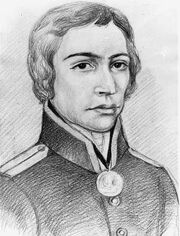
|
This Russian America Article is a Stub The creator of this timeline is seeking help in the development of this article. You have permission to expand it. Please familiarize yourself with the editorial guidelines before making any edits. |
| ||||||||
| Capital | Yukaya | |||||||
| Largest City | Ross | |||||||
| Other Cities | Kuskovo, Vayrika, Zavalishino | |||||||
| Language Official |
Russian (de facto) | |||||||
| Others | Chinese, Greek, Spanish | |||||||
| Religion Main |
Eastern Orthodox | |||||||
| Others | Buddhists, Catholics, Jews | |||||||
| Ethnic Groups Main |
Russians and Ukrainians | |||||||
| Others | Armenians, Chinese, Greeks | |||||||
| Demonym | Sonoman, Sonomets | |||||||
| Legislature | Gubernial Duma | |||||||
| Area | 87,519 km2 (76,902 sq. versts) | |||||||
| Population | 14,273,601 (2017 Census) | |||||||
| Established | September 9, 1850 | |||||||
| Admission | October 2, 1931 | |||||||
| Time Zone | AKEST (UTC-8) | |||||||
| Summer | AKEDT (UTC-7) | |||||||
| Abbreviations | AK-SO, Сон. (Son.) | |||||||
The Sonoma Governorate (Russian: Сономская губерния, Sonomskaya guberniya), colloquially known as Sonoma (Сонома), is a governorate of Alaska. It is bordered in the north by the Oregon Governorate and in the southeast by the Mexican provinces of Nevada and Vallejo. Sonoma is the largest governorate by population, comprising roughly 23% of the nation's total population. The city of Ross is also the largest city in Alaska and one of the nation's economic centers.
Etymology[]
The name Sonoma was borrowed from the Pomoan and Utian phrase цо-нома (tso-noma), which roughly translates as the "Valley of the Moon." Prior to the formal adoption of Sonoma in 1850, the area was also referred to as the "Ross Colony" (Колония Россь, Koloniya Ross) and "Russian California" (Русская Калифорния, Russkaya Kaliforniya).
History[]
Prior to the discovery of the Americas, the territory of Sonoma had been inhabited by native groups for millennia. The Miwok, the Pomo, and the Shasta were among the most prominent cultures in the area.
The Spanish were the first Europeans to explore the area, with Juan Rodríguez Cabrillo exploring the coast as far north as modern-day Oregon. Spanish missions would be established across the coast from San Francisco Bay to the tip of the Baja California Peninsula. The English and the French also explored the area with intentions of colonization, with Sir Francis Drake of England going as far as to claim territory in the area.
Under the leadership of Aleksander Baranov, the Russian-American Company looked to expand the company's interests into the Californias and Oregon. Beginning in 1808, the RAC authorized several exploratory expeditions with the intent of establishing an agricultural colony to help feed the northern colonies of Russian America. Headed by Ivan Kuskov, a Russian base was established in 1812 near Rumyantsev Bay. For the next decade, Fortress Ross and the nearby ranches would become a success for the Russian Empire.

Ivan Kuskov (c. 1810s).
The Kingdom of Spain attempted to remove the Russian colonists by force in March 1822. The Russian colonists were able to force the Spanish to retreat, sparking the Great Western War. At the war's conclusion in 1824, the Russian Empire and the newly recognized Mexican Empire came out as the victors. Russia would formally control and Slavianka River Valley, but it wouldn't be until years later that Dmitry Zavalishin would successfully purchase all of the territories west of the Sacramento River from Mexico.
The Russian-American Company would continue its administrative duties over Russian America until 1841, when Tsar Nicholas I formally annexed the territory and organized it into integral territories of the Russian America.
| |||||||||||||||||||||||




